Best Sounding Acoustic Guitar: Top 5 Picks for Perfect Tone

Creating a musical masterpiece with your bare hands isn’t easy. To create a symphony that grows over time requires delicate woods, strings, and the perfect guitar.
Acoustic guitars are more than just instruments; they are a ride to a melody sound. The acoustic guitar is the best in the sound category because of its tonewoods, body shapes, and string types. These elements create authentic, harmonious blends.
But what to buy and where to buy? There are hundreds of brands out there for acoustic guitars, and most importantly, how do you know they sound the best? That’s what we will explore today.
Key Highlights: Best Sounding Acoustic Guitar
- Zager ZAD80 has an all-in-one rosewood back and sides, dreadnought body, and bracing system string for no finger bites. And everything aligns to give the perfect sound.
- Martin D-28 is a popular guitar with a rich, balanced sound made from spruce.
- Taylor 814ce is known for its clear, bright tone for versatile use.
- The Gibson J-4 has the perfect mellow sound for your favorite folk or country genre.
- Yamaha LL16 is affordable and has the ideal balanced tone for fingerpicking.
Factors that Determine the Best Sounding Acoustic Guitar
When searching for a sounding guitar, brands shouldn’t be your first concern. You should look for what the guitar is made of. The true foundation lies within the tonewoods, body shapes, and string types. Let’s dissect how they are the foundation of the acoustic guitar.
Tonewoods: The Foundation of Acoustic Guitar Sound
Tonewoods give the overall shape to the guitar sound. At first, it might seem that they are just the outer skeleton of the guitar, but they aren’t. With every different wood, you will have unique tonal characteristics.
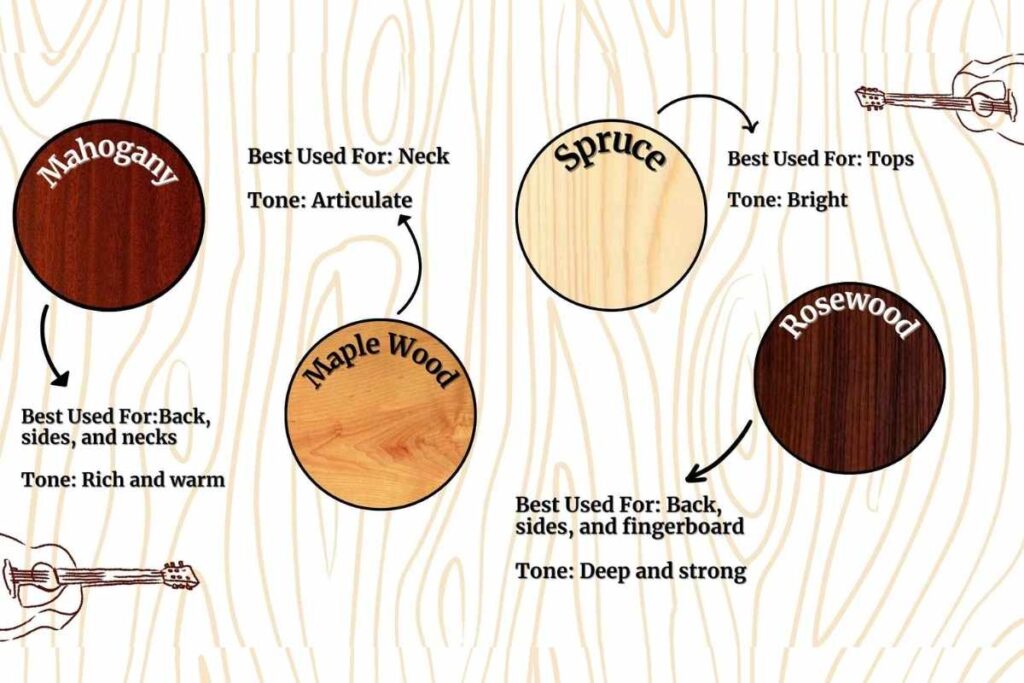
Related Read: Best Wood for Guitar Body.
| Woods | Description | Sound |
| Mahogany | This one goes on the back, sides, and necks of the guitar. It is more reddish-brown and has a straight-grain pattern. | It gives a warm, rich timbre focusing on pronounced midrange frequency. |
| Rosewood | Another popular choice for the back, sides, and fingerboard of the guitar. It has a dark brown shade with a distinctive grain pattern. | Rosewood is the home name for its complex tonal characteristics. It gives you a deep, strong, and resonant bass sound. |
| Spruce | The top of the guitar is mainly made of spruce wood. You can identify them with their light-colored, visible grain pattern. | The sound of the spruce is very articulate and clear. It has a bright sound projection. |
| Maple | You will mostly see maple on the necks of acoustic guitars. It is made out of single wood that comes under the solid wood. | This tonewood also participates in the bright, articulate tone. |
Body Shape and Size: How It Influences Sound
The body shape and size also play a part in the sound. The guitar shapes and sizes determine the levels of volume, projection, and tonal characteristics.
| Guitar shape and size | Affects on sound |
| Dreadnought | The most common body shape in the guitar industry. It is bigger and heavier than any other guitar. The sound from it comes out full, balanced with a deep bass response. |
| Concert and Grand Concert | Smaller than Dreadnought and other standard guitar sizes. It offers a more focused and intimate tone for the closed events. |
| Jumbo | With a large, rounded body, jumbo guitars present a loud, growling sound with plenty of projection. |
| Auditorium | Hitting a balance between volume and tonal intricacy, auditorium guitars deliver an adaptable sound suitable for various musical styles. |
Relatable reads: 7 Acoustic Guitar Body Types, Sizes, Shapes, & Differences.
String Type and Gauge: Key Contributors to Sound Quality
The type of strings and gauges in the acoustic guitar can specify the kind of sound you will get. What strings offer is the brightness, warmth, and playability.
| Strings | Impact on the sounds |
| Light Gauge | Light gauges are the beginner-friendly string. It is easier to play and has the softest and delicate sound. |
| Medium and Heavy Gauge | These strings require more finger strength and are perfect for powerful strumming patterns. Its sound is louder and fuller. |
| Phosphor Bronze and 80/20 Bronze | Phosphor bronze strings will give you a balanced tone, while 80/20 bronze strings will satisfy your liking for a brighter and more metallic sound. |
Top 5 Best Sounding Acoustic Guitars in 2024
Time for the big reveal!
Here are the five best acoustic guitars if the sound quality means a lot to you.
1. Zager ZAD80: Bold, Resonant Sound
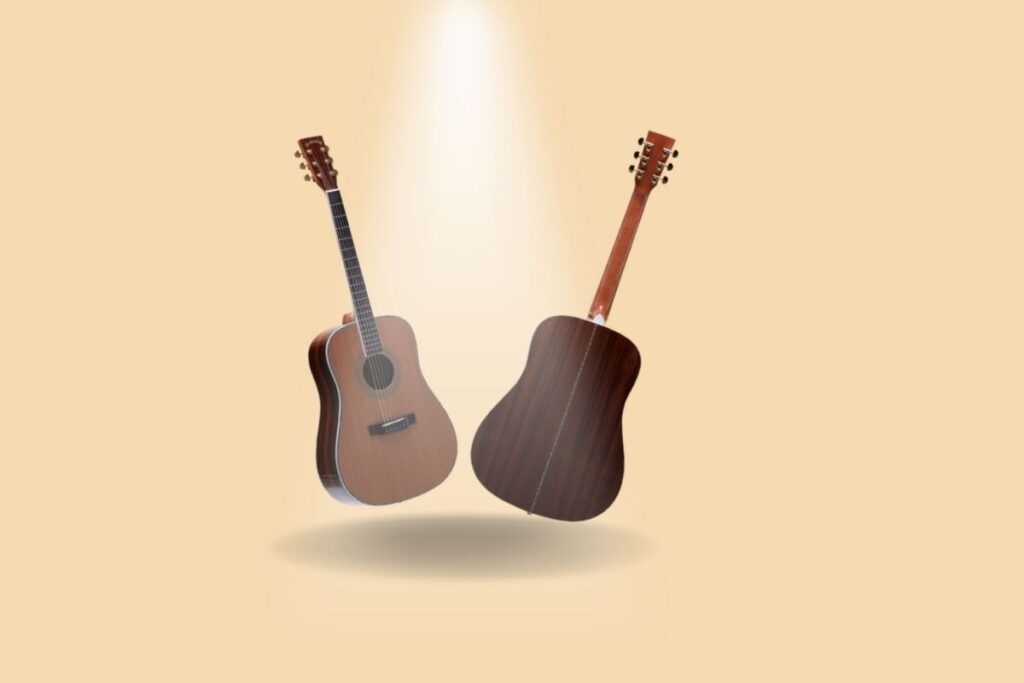
| Features | Description |
| Body | Dreadnought |
| Top | Red Cedar Top |
| Back and Sides | Indian Rosewood |
| Neck | Mahogany |
| Fingerboard | Bolivian Rosewood |
| Bracing | A special bracing system with more bass |
Why is it best for sound quality:
The sound of the Zager ZAD80 is more powerful and more profound than any other acoustic guitar. Their body is made out of red cedar top, and Indian Rosewood back and sides provide a rich, full tone with a strong bass response. Not only the tonewoods but their string bracing system produces one of the best sounds in the guitar industry today. The ZAD80’s flawless projection makes it superior for performing in large venues or for playing in a band setting.
2. Martin D-28: The Legendary Sound
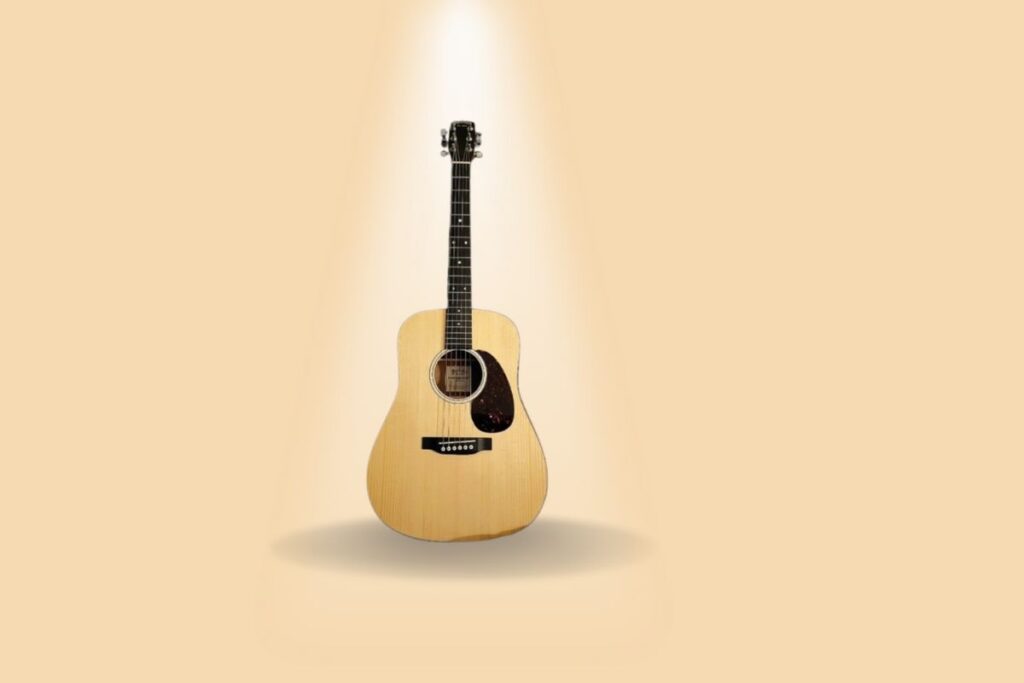
| Features | Description |
| Body | Dreadnought |
| Top | Spruce |
| Back and Sides | East Indian Rosewood |
| Neck | Mahagony |
| Fingerboard | Ebony |
| Bracing | Forward-Shifted X-Brace |
Why is it best for sound quality:
The Martin D-28 is the old famous acoustic guitar for its rich, balanced sound. They have the Spruce top and East Indian Rosewood back and sides to give that deep bass sound. The sounds are more likely to come with much clarity and high notes. If you’re into both strumming and flat-picking styles, make it a versatile choice for any player.
3. Taylor 814ce: Balanced Tonal Excellence
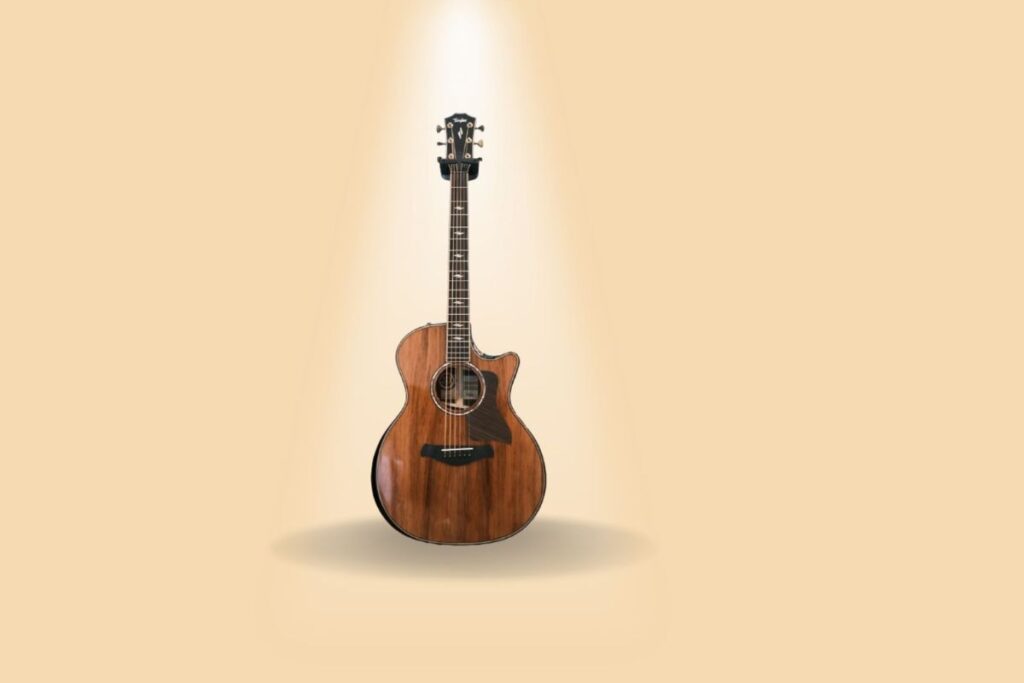
| Features | Description |
| Body | Grand Auditorium |
| Top | Sitka Spruce Top |
| Back and Sides | Indian Rosewood Bac |
| Neck | Tropical Mahogany |
| Fingerboard | West African Crelicam Ebony |
| Bracing | V-Class bracing |
Why is it best for sound quality:
The Taylor 814ce responds with a warm low because of the bracing system. They have one of the versatile sounds that help musicians of all levels. The making behind the 813ce is the reason it gives a bright, clear tone with rich mids and a strong low-end response. It makes them a popular choice for both solo playing and performing in a band setting.
4. Gibson J-45: Iconic, Warm Sound
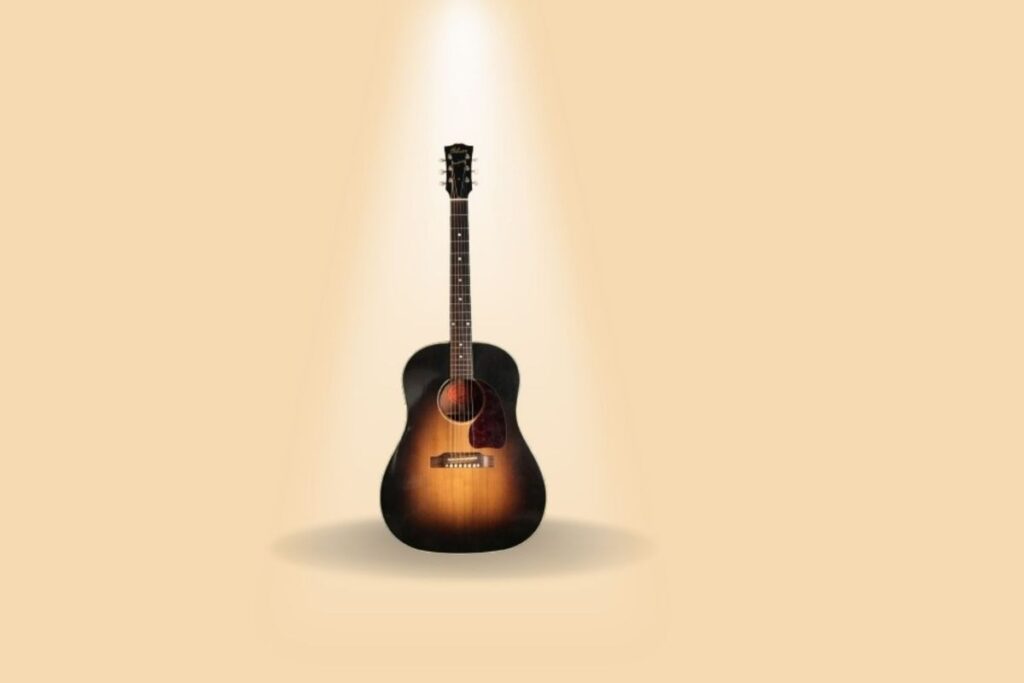
| Features | Description |
| Body | Round shouldered dreadnought |
| Top | Sitka Spruce |
| Back and Sides | Mahogany |
| Neck | Mahogany |
| Fingerboard | Rosewood |
| Bracing | Traditional Hand-scalloped X-bracing |
Why is it best for sound quality:
The classic acoustic guitar from Gibson. The Gibson J-45 introduces itself with its warm, mellow tone and low-end solid response. The Mahogany body and Rosewood fingerboard provide a rich, full sound that is perfect for blues, folk, and country music. On top of that, the traditional bracing system they used makes it preferable for both strumming and fingerpicking.
5. Yamaha LL16: Affordable Excellence
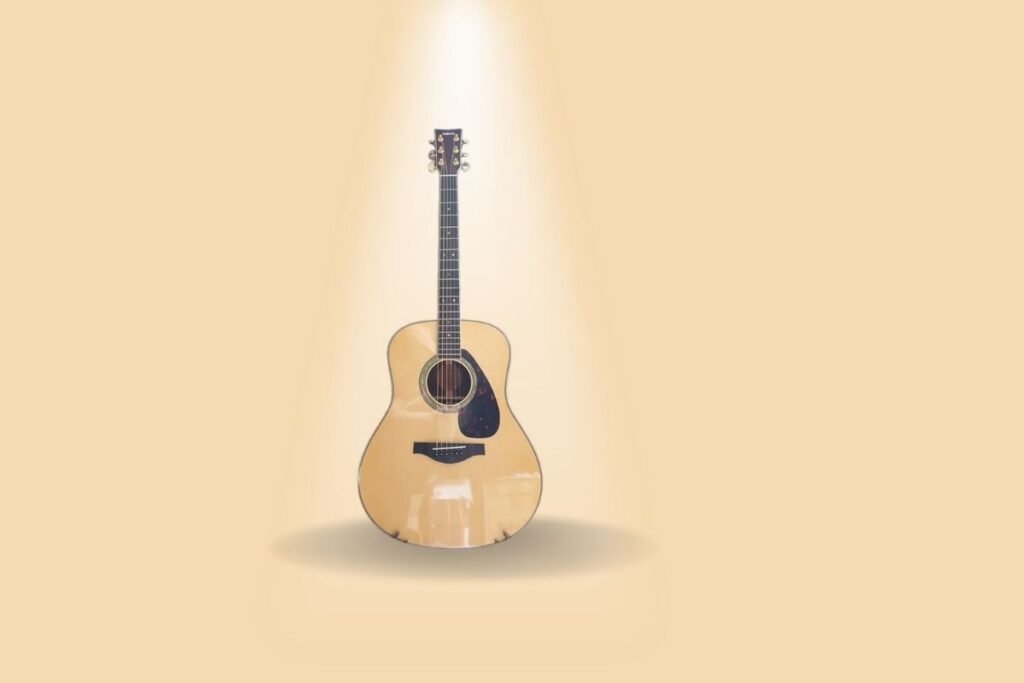
| Features | Description |
| Body | Jumbo |
| Top | Spruce |
| Back and Sides | Solid Mahogany |
| Neck | Mahogany + Rosewood |
| Fingerboard | Ebony |
| Bracing | Traditional X-bracing |
Why is it best for sound quality:
Here comes the affordable goodness. The Yamaha LL16 is both affordable and has the desirable sound quality. Their solid Engelmann Spruce top and Rosewood back and sides provide a balanced, clear tone perfect for fingerpicking. Since LL16 has a comfortable neck and smooth action, it is easy to play. Both beginners and experienced musicians want it.
How to Choose the Best Sounding Acoustic Guitar for Your Style?
Understanding Different Playing Styles and Their Sound Needs
You are giving importance to the sound because you want a specific sound that matches your playing style, right? You wouldn’t think much about the sound quality if you don’t have a particular preference for playing style. So, it can be said that playing style influences the acoustic guitar sound.
Let’s have a look at some common playing styles and their sound preferences:
| Playing Style | Pattern | Guitar body type | Sound Output |
| Strumming | This follows a rhythmic pattern. | Dreadnought guitars are often chosen for strumming due to their powerful projection. | The final result is a loud, resonant sound, especially in the bass frequencies. |
| Fingerpicking | It requires playing each note with your fingers. | Auditorium guitars are the best for fingerpicking to have that balanced tone and intimate sound. | It makes a more focused sound with clear trebles. |
| Hybrid Styles | The best of two worlds: strumming and fingerpicking. | Smaller shapes like concert guitars provide a soft, warm sound that is not so loud. | The balanced tonal range comes from both strumming and fingerpicking. |
Tone Preferences: Bright vs. Warm
The acoustic guitar is well known for its tonal characters. This feature makes it stand out from other guitar types in the market. From bright and clear to warm and mellow, your personal preference for tone will decide which one to select.
1. Bright Tones
If genres like folk or bluegrass are your gig, then your guitar choices should be around the bright tone. These bright-tone guitars have a more pronounced treble response for your favorite folk songs. Besides that, you can look for spruce and maple tonewoods because these woods are known for their brighter tone production.
2. Warm Tones
You probably have a soft spot for warm tones if you’re a jazz, pop, or country music fan. Guitars with warm tones really bring out the bass and have a richer midrange. Regarding tonewoods, mahogany and rosewood are the way to go. They’ll give you that cozy, mellow feel in the tone.
Budget Vs. Sound Quality: Is There a Compromise?
We will talk about the budget. Even though sound quality here comes as the priority, you can’t ignore the budget.
The budget should be on the consideration list for whichever acoustic guitar you purchase. So, why not talk about both cost categories, premium and cheaper, aka pocket-friendly options?
| Premium Options | Budget-Friendly |
| It is pretty predictable if you aim for a high-end brand like Martin and Taylor. Their higher price tags come from their superior craftsmanship, tonewoods, and overall quality. They will kind of break your bank, but the exceptional sound quality and longevity will ease your pain. | First, being budget-friendly doesn’t mean lower quality. Zager and Yamaha have proved that one can have the best-sounding guitar even at a lower cost. While they may not have the same level of prestige as premium brands, they can still provide exceptional sound quality and playability. |
Relatable reads: Best Acoustic Guitar Under $1000 (7 Pro Picks)
Caring for Your Acoustic Guitar to Maintain the Best Sound
Okay, imagine you have just bought a guitar. But that’s not the end of it. If you want your guitar to sound good throughout the year, you must take care of it. Remember, even the best quality guitar can deteriorate if not appropriately handled.
Proper Storage and Humidity Control
Keep the humidity in control
- Maintain the humidity level of your acoustic guitar around 40 to 60%.
- Try to avoid both excessive and low humidity.
Use proper guitar storage
- Buy a good-quality guitar case that can maintain humidity levels.
- Avoid direct sunlight and heat sources.
- Loosen the strings when storing for extended periods.
Buy the best guitar case from here: Zager Cases.
String Maintenance and Replacement
- Look out for worn strings like dull sound, difficulty tuning, and excessive fret wear.
- Wipe down your strings after each playing session.
- Be careful when tuning your strings to avoid over-tightening.
- Use a string winder to prevent excessive tension.
- Replace the strings every 2- 3 months, depending on factors such as playing frequency, string gauge, and personal preference.
Cleaning and Polishing: Keeping Your Guitar in Peak Condition
When you clean and polish your guitar, its appearance and finish stay intact. Regular cleansing also ensures that your guitar won’t lose its resonance. Follow these tips below to clean the guitar.
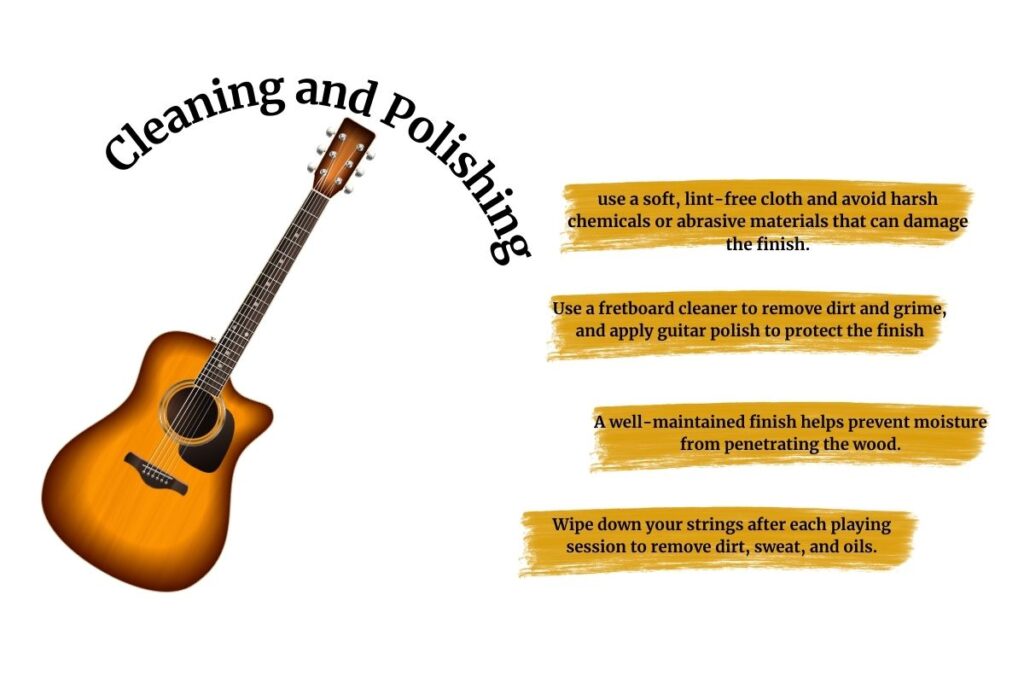
Frequently Asked Questions
1. Tonewood
2. Guitar body type
3. Strings type
4. Playing techniques
Concert and grand concerts are usually seen as the best acoustic guitars for fingerpicking. Because they have petite bodies and easily accessible strings, they can focus on warm, intimate sounds.
Yes, cheap does not always mean low quality. Surprisingly, a budget guitar can sound good, even sometimes better. Just look out for the tonewoods, craftsmanship, and playing setup. Other than that, you are good to go.
With lighter strings, you will hear a more soft and bright tone without putting too much tension on the fingers. Heavy strings have a dark, warm tone. They produce a vibration in the sound and most likely tense the fingers.
String replacement actually varies depending on which string gauge you are using or your playing style. If you ask for a specific time, then it is recommended to change the string every 2 to 3 months.
Have you found your best-sounding guitar?
So, we are almost done. There is nothing complicated about the guitar sound. Just keep a few things in mind: guitar tonewoods, body shape and size, and string type. The brand that stands out the most is Zager. It checked all three categories to determine the best sound. So you can make your purchase from them without any doubts.
